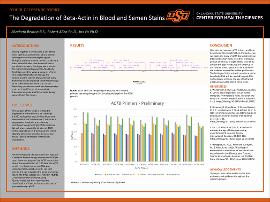| dc.contributor.author | Beaton, Elizabeth | |
| dc.contributor.author | Allen, Robert | |
| dc.contributor.author | Fu, Jun | |
| dc.date.accessioned | 2023-09-12T16:44:59Z | |
| dc.date.available | 2023-09-12T16:44:59Z | |
| dc.date.issued | 2022-02-18 | |
| dc.identifier | ouhd_Beaton_degradationofBeta-Actin_2022 | |
| dc.identifier.citation | Beaton, E., Allen, R., & Fu, J. (2022, February 18). Degradation of Beta-Actin in aging blood and semen stains. Poster presented at Research Days at Oklahoma State University Center for Health Sciences, Tulsa, Ok. | |
| dc.identifier.uri | https://hdl.handle.net/11244/339531 | |
| dc.description.abstract | Piecing together a crime scene is one of the most significant components of any forensic investigation and estimating the age of biological stains at a scene can be crucial to the case. Several studies have demonstrated a correlation between the degradation kinetics for mRNA transcripts present in dried body fluid stains aged for varying amounts of time. The relationship between the age of a sample and the state of degradation of many transcripts can be exploited to estimate the age of an unknown crime scene stain. In this laboratory, preliminary work has demonstrated that the 5’ and 3’ ends of many mRNA transcripts degrade at different rates during aging of body fluid stains. The purpose of this study is to map the degradation of the entire ACTB transcript (~1800 nucleotides long) in dried blood and semen stains and to determine if variances in degradation sensitivity are uniformly distributed along the length of the molecule. We will also evaluate the kinetics of ACTB mRNA degradation in dried blood and semen stains to determine whether there are any tissue-specific differences in transcript degradation. To date, we have designed qPCR primers that span the whole length of the ACTB transcript to direct the amplification of ~100 base pair qPCR amplicons. We have identified the amplification efficiencies for our collection of primers and are now ready to begin the study of ACTB degradation in stains stored for increasing periods of time. The findings of this study will contribute to the knowledge that will be needed to apply this technology to estimate the age of biological evidence recovered from a crime scene. | |
| dc.format | application/pdf | |
| dc.language | en_US | |
| dc.publisher | Oklahoma State University Center for Health Sciences | |
| dc.rights | The author(s) retain the copyright or have the right to deposit the item giving the Oklahoma State University Library a limited, non-exclusive right to share this material in its institutional repository. Contact Digital Resources and Discovery Services at lib-dls@okstate.edu or 405-744-9161 for the permission policy on the use, reproduction or distribution of this material. | |
| dc.title | Degradation of Beta-Actin in aging blood and semen stains | |
| osu.filename | ouhd_Beaton_degradationofBeta-Actin_2022.pdf | |
| dc.type.genre | Presentation | |
| dc.type.material | Text | |
| dc.subject.keywords | RNA degradation | |
| dc.subject.keywords | age estimation | |
| dc.subject.keywords | blood stains | |
| dc.subject.keywords | semen stains | |
| dc.subject.keywords | forensic investigation | |
